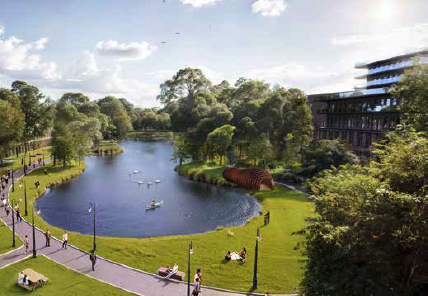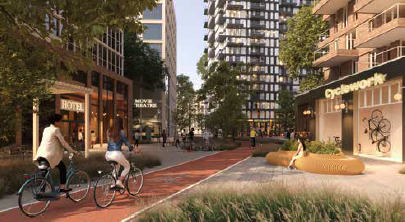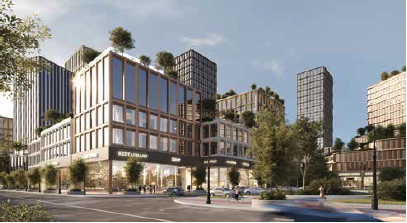by Kelly Smith

At UM Properties GP Inc., sustainability goes beyond surface-level— it’s a measurable commitment. Under the leadership of CEO and President Greg Rogers, the land development company is redefining what it means to build with the environment, ecosystems, and community well-being in mind.
“You know what a happy tree looks like, right?” says Rogers. “It looks healthy and leafy. A happy fox is something that looks well fed. I just look for that everywhere – how can I get more of that kind of happiness?”
Over the past five years, Rogers has brought that perspective to the planning and development of Southwood Circle, a transformative new community rising on the former Southwood Golf and Country Club land, adjacent to the U of M campus in south Winnipeg. The overarching goal of his development team’s efforts, Rogers says, is “creating places where both nature and people can coexist.”
LEADING WITH PURPOSE
Rogers has worn many hats over the course of 30-plus years in the property development field throughout Canada and the U.S. His resume includes steering shopping centres and office buildings at Cadillac Fairview and Truscan to leading industrial, hotel, and mixed-use projects at First Gulf.
For the last decade, Rogers’ focus has been on urban infill and multifamily residential developments, including high-rises and condos. Just before joining UM Properties, he led Timbercreek’s multifamily development program in Canada, specializing in intensifying urban properties. Returning to Winnipeg in 2019 – to begin planning the ambitious 12,000-unit, mixed-use Southwood Circle project – felt like the perfect opportunity for Rogers to bring his expertise full circle and make a lasting local impact.

Designed as a walkable, transit-oriented urban village, the project combines housing, retail and public spaces with large scale natural restoration, energy innovation, and Indigenous collaboration. UM Properties has also brought some outside expertise on board for certain elements of the site design: To enhance the outdoor recreation component, Rogers reached out to Alex Mann – the trail designer behind the Calgary Olympics mountain bike courses – to create custom cycling trails on-site.
“By leveraging natural systems like these, we’re not only exceeding Manitoba’s typical stormwater treatment standards but doing so with a modest investment that delivers significant environmental benefits.”
Rogers’ hope is that Southwood Circle’s eventual residents and visitors will form lasting impressions of its meticulous design, with sustainability at the forefront. His lifelong passion for sustainable development is well chron icled. An early proponent in that field, Rogers led one of the first full-portfolio retrofits of office buildings in Canada in the 1990s, and he also joined environmental activist David Suzuki on a speaking tour to promote commercial building sustainability.
Admittedly, his outspokenness on the issue has led to some occasional pushback from the industry. It’s a challenge he accepts wholeheartedly.
“Respectful challenge is good,” says Rogers, noting that driving real change in commercial real estate will always be a worthwhile endeavor. “If I can’t defend my beliefs or what I’m doing, maybe they’re not that strong.”
Rogers also insists that true environmental stewardship extends beyond ticking boxes on a sustainability ‘scorecard’. Meaningful change, he says, comes from applying scientific rigor and tracking measurable outcomes. “It’s about applying real data to prove we’re making a difference,” he says.
RESTORING LAND WITH SCIENCE AND STEWARDSHIP
Collaborating with the U of M’s biology department to apply cutting-edge research, the Southwood Circle development blends environmental care with business sense. One standout example is the work done in partnership with Ducks Unlimited on the site’s stormwater pond. Carefully selected plant species were introduced to absorb and neutralize harmful chemicals like phosphates before water returns to the river.
“By leveraging natural systems like these, we’re not only exceeding Manitoba’s typical stormwater treatment standards but doing so with a modest investment that delivers significant environmental benefits,” says Rogers.
The project team’s vision certainly goes beyond carbon math — it’s driven by the desire to restore ecosystems, respect local knowledge, and create lasting community value. That starts with understanding the land as it existed before development began.
Protecting natural carbon sinks, specifically Manitoba’s forests and wetlands that absorb atmospheric carbon is a key part of their strategy. “We have a carbon sink that nobody talks about,” says Rogers. “If we take care of that properly, it can make a huge difference.” He notes that the focus shouldn’t be merely to reduce emissions, but to actively support nature’s ability to fight climate change.

One unexpected challenge came from City of Winnipeg requirements for an “urban profile” which called for burying water infrastructure and removing surface ditches. While this met urban design standards, it interfered with natural ecological functions.
“A pivotal ‘aha’ moment came in recognizing that adhering strictly to conventional engineering practices and municipal policies would have meant sacrificing the very qualities that make this land so special,” Rogers explains. That insight pushed the team to find ways of preserving natural processes within urban design requirements.
“People see ditches as messy,” Rogers notes, “but they filter water, help keep the soil moist, and support nearby plants.” By eliminating these natural features, he argues, we risk disrupting the very systems that make the landscape resilient.
To address this, UM Properties reactivated a legacy irrigation system that draws from the nearby river—restoring moisture to areas once sustained by surface ditches. The solution honours how water once moved through the land, striking a balance between ecological function and city requirements.
“You have to start from what was here before you showed up,” Rogers says. “What was already living here, what the land was doing naturally, and what kind of systems were already working.” This includes native birds, foxes, and pollinators whose habitats were carefully studied before development begins.
The UM Properties team is keen to build green spaces that support local biodiversity, reconnect natural corridors, and help native species thrive. Over 800 large caliper trees have been planted, including the reintroduction of native species that had long since disappeared from the area. Disease-resistant varieties of Elm and Ash trees were also selected to enhance long-term biodiversity and resilience.
With over 30% of the site dedicated to natural habitat, Southwood Circle will incorporate native plants, extensive tree canopies, and stormwater systems designed to replicate the land’s original ecosystems.
BUILDING THE BLUEPRINT FOR LOW-CARBON LIVING
On the energy side, the team is exploring a district geothermal system that taps into Manitoba’s underground aquifer. This approach is needed because the Southwood Circle development calls for many new buildings, including multi-family residential, office, mixed-use, and recreational. While some buildings are interconnected and others stand alone, all will require efficient heating and cooling solutions. In partnership with Efficiency Manitoba, test wells are underway to evaluate the potential of an open-loop design.
Early findings suggest the system could support the entire first phase of development, roughly 3,000 residential units, while cutting on-site energy use by as much as 50-75%. If implemented, it would mark a significant leap forward in energy efficiency.

“Efficiency Manitoba is exploring the opportunities presented by ground source district systems to use shared geoexchange to provide energy efficient heating and cooling to Manitoba buildings,” says Lindsay Robinson, Mechanical Systems Technical Lead and professional engineer with Efficiency Manitoba.
“Through financial support from our Innovation Fund, this feasibility study will assess the technical and financial viability of an open-loop ground source district system approach to multi-unit residential buildings for the Southwood Circle development.”
The study will evaluate system design, costs, and projected energy savings. “These results will be very informative for both the company as it proceeds with development planning, as well as for Efficiency Manitoba to help determine the potential energy savings that future programs and funding could be designed around,” Robinson adds.
The buildings themselves are designed to exceed provincial standard, with integrated solar panels, advanced HVAC systems, and smart meters enabling real- time energy monitoring. A standout feature is the Living Lab partnership with the U of M, where ongoing research tracks environmental outcomes and supports continuous improvement through adaptive management.
ROOTED IN CULTURE, DESIGNED FOR COMMUNITY
The development team has already built strong relationships with the National Centre for Truth and Reconciliation, Elders-in-Residence, Governing Circle and Survivors Circle, whose guidance has been instrumental in shaping the project’s direction. At the Survivors Circle recommendation, the development was renamed “Southwood Circle” to reflect the cultural importance of the circle as a symbol of unity, continuity, and interconnectedness.
This concept, says Rogers, has become a central theme in the community- building approach and in honouring the land.
“It’s about more than saving energy, it’s about vibrant, living systems,” explains Rogers.
Rogers ensures every team member understands not just what they do—but why it matters. Their approach turns community input and environmental considerations into purposeful action— whether its planting native medicinal grasses guided by Indigenous knowledge or creating habitats for local pollinators.
Southwood Circle may be located in Winnipeg, but its impact will certainly extend far beyond the city. Greg Rogers and his team are creating a case study in sustainable mixed-use development rooted in integrity, science, and cultural respect.
“Looking ahead,” says Rogers, “we hope that this evolving body of evidence can help influence broader policy, inspire other developers, and support a shift in how communities are planned and built across Canada.”